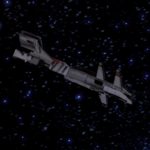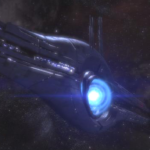System Specs:
- Stellar Mass: 0.788 Sol Masses
- Stellar Class: K0
- Luminosity: 0.4 Sol
- Planets: 4
- Moons: 0
- Asteroid Belts: 0
- Asteroids: 0
- Objects: 1

–
Planets Directory:
- Svarog
- Noveria
- Morana
- fuel depot
- Veles
- Mass Relay
–
Svarog:

- Orbital Distance: N/A AU
- Orbital Period: 0.2 Earth-years
- Keplerian Ratio: N/A
- Radius: 32,285 km
- Day Length: 13.4 Earth-hours
- Atmospheric Pressure: N/A atm
- Surface Temp: N/A °C
- Surface Gravity: N/A g
- Mass: N/A Earth-masses
Svarog is a small but typical hydrogen-helium gas giant whose orbit is quite close to the star. It is unusual for a star with a close orbiting gas giant to have a habitable world. Svarog is Pax’s only gas giant, but its temperature, powerful winds, and high orbital velocity make it a poor candidate for helium-3 mining. While Noveria enjoys plentiful deuterium for its fusion plants, it imports all of its helium-3 from out-system.
Mass Effect 3
Svarog is Pax’s only gas giant, but its temperature, powerful winds, and high orbital velocity make it a poor candidate for helium-3 mining. While Noveria enjoys plentiful deuterium for its fusion plants, it imports all of its helium-3 from out-system.
Like most pegasids, Svarog is thought to have formed outside the frost line of its parent star and migrated inward due to an unstable orbit. Its small size compared to the usual hydrogen-helium gas giants is likely due to hydrodynamic escape. Since it orbits closer than 0.015 AU, the planet’s atmosphere is likely soon to be consumed. Scientific debate continues on how the other planets in the system survived Svarog’s migration, as its gravity may have played havoc with them early in their formation.
–
Noveria:

- Orbital Distance: 0.9 AU
- Orbital Period: 0.9 Earth-years
- Keplerian Ratio: 0.9
- Radius: 5,656 km
- Day Length: 52.0 Earth-hours
- Atmospheric Pressure: 0.87 atm
- Surface Temp: −1 °C
- Surface Gravity: 0.81 g
- Mass: 0.63 Earth-masses
- Colony: Port Hanshan (capital), founded 2163, population 361,400 (2183), 405,200 (2186)
Noveria is a small, frozen terrestrial world, barely habitable by conventional definitions. It is privately chartered by the Noveria Development Corporation, who lease out labs to perform research too dangerous or controversial to be performed elsewhere. Given Noveria’s unique situation, it is the source of many wild conspiracy theories.
Mass Effect 3
Noveria is a small, frozen terrestrial world, barely habitable by conventional definitions. It is privately chartered by the Noveria Development Corporation, who lease out labs to perform research too dangerous or controversial to be performed elsewhere.
The war has brought significant attention to this otherwise obscure planet. Noveria is home to some of the most advanced research in the galaxy, a sure magnet for Cerberus interest. Further, Noveria’s mass relay is the stop between the humans’ Exodus Cluster and the beginning of salarian space. It is a safe bet that the salarians will defend their borders to the utmost.
Codex Entry
Noveria is a cool, rocky world, with most of its hydrosphere locked up in massive glaciers. A privately-chartered colony world, the planet is owned by the Noveria Development Corporation holding company. The NDC is funded by investment capital from two dozen high technology development firms, and administrated by an Executive Board representing their interests.
The investors built remote hot labs in isolated locations across Noveria’s surface. These facilities are used for research too dangerous or controversial to be performed elsewhere, as Noveria is technically not part of Citadel space and therefore exempt from Council law.
By special arrangement, Citadel Special Tactics and Reconnaissance agents have been granted extraterritorial privileges, but it remains to be seen how committed the Executive Board is to that principle. Given its unique situation, it is understandable that Noveria is often implicated in all manner of wild conspiracy theories.
Additional Information
Skiing while scheming: only in Noveria
Noveria features the Skadi Mountains, where the isolated lab Peak 15 is situated in, and the Aleutsk Valley, a pass between Port Hanshan and Peak 15. Locales known to Noverian denizens include a resort at the equator that provides amenities like accredited asajura fields and caters to other leisure activities like bouncebacking and diving.
Aside from sapient races, known lifeforms on the planet include nathak.
–
Morana:

- Orbital Distance: 6.3 AU
- Orbital Period: 17.7 Earth-years
- Keplerian Ratio: 0.798
- Radius: 1,089 km
- Day Length: 17.7 Earth-hours
- Atmospheric Pressure: 0.0 atm
- Surface Temp: −158 °C
- Surface Gravity: 0.1 g
- Mass: 0.003 Earth-masses
Morana is an icy planetoid smaller than Earth’s moon. Many planetary geologists suspect it was once an Oort cloud “ice dwarf” which migrated inwards after an encounter with some other body. While the crust is frozen water ice, deeper layers are mostly silicates, with pockets of magnesium and aluminum. Morana is tidally locked to Pax; the same side always faces the sun.
–
Veles:

- Orbital Distance: 24.5 AU
- Orbital Period: 136.3 Earth-years
- Keplerian Ratio: 0.792
- Radius: 7,547 km
- Day Length: 62.0 Earth-hours
- Atmospheric Pressure: 0.07 atm
- Surface Temp: −220 °C
- Surface Gravity: 1.7 g
- Mass: 2.36 Earth-masses
Veles has a thin atmosphere of xenon and krypton – most other materials have frozen and fallen as snow. Its surface is composed of potassium with deposits of magnesium. While investigating the primitive anaerobic life of Veles, Binary Helix survey teams discovered a cunningly hidden anchorage of the ancient krogan warlord Moro. Many records and artifacts of the Krogan Rebellions were recovered and sold at auction. The empty base is now abandoned.
–
–
video









